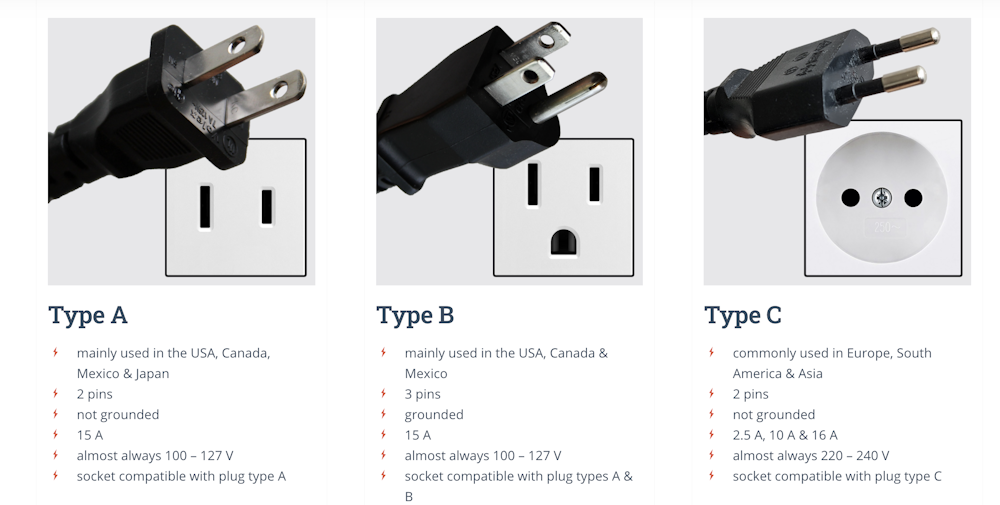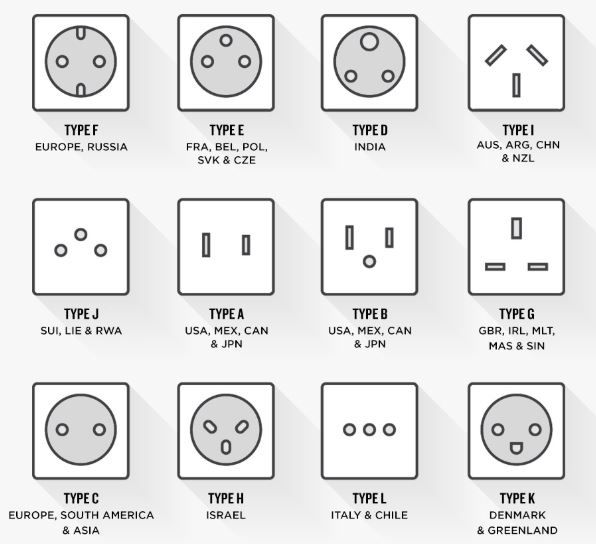The biggest difference between European and American electricity is the voltage. The difference between voltages in the US.

Why Do Different Countries Have Different Electric Outlet Plugs Warrington
C F L.

. I think you meant a step-down transformer. Virgin Islands British A B. American appliances will literally blow up if you are able to get them plugged in over there.
There are approximately 40 countries that use 60 Hz while the rest typically run on 50 Hz current. Europe having watched electrical development in the US doubled the 110220 volts to 220240 to reduce wire size and thus wiring costs. The system of three-phase alternating current electrical generation and distribution was invented by a nineteenth century creative genius named Nikola Tesla first.
One of the most obvious differences between the electrical standards of Europe and the US. Tue Mar 25 2008 1206 am Post subject. European electricity reverses 50 times per second 50Hz.
The air actually starts conducting electricity. Most amp companies use transformers for different voltages you can either choose the voltage by a selector or solder one wire to the desired. While generation capacity has increased slightly this is.
The notation for this is 60Hz. What about the voltage differences in Europe and the USA. A B C.
The United States power grid is much less well integrated but all over North America the voltage is a nominal 120 volts. Europe having observed the pros and cons of 60 cycles and 110240 V current decided that 50 cycles and 220 V volts was more cost-effective than the US system. Europe having observed the pros and cons of 60 cycles and 110240 V current decided that 50 cycles and 220 V volts was more cost-effective than the US system.
For the USA and Japan where voltages are 110V you need the step-up convertor to achieve the 220240V needed for the Idromed to work. Posted on April 30 2018 by Roger Andrews. All you need to remember is that standard voltage in the United States is 120 while in Europe its 220.
60 Hertz USA 230 Volt. Otherwise the appliance will be easily damaged because of the different voltage. This video is describing the difference between European and US electrical service and what to be aware of if you buy a piece of equipment straight from the.
The price of residential electricity has risen in lockstep with growth in renewable capacity in Europe but not in the US and because of this European residential electricity rates are now roughly twice US rates. The electrical Voltage and Hertz are different in different parts of the world roughly you can distinguish. In many countries including Europe using 220V50Hz system.
As a result these countries must use specially designed appliances for specific power supply connection. But in the US. Each country is listed with the volts and frequency also referred as Hertz or Hz and is referring to cycles per second commonly found in each geographic area.
120 and 220 Volt. Europe and most other countries in the world use a voltage which is twice that of the US. In the US charging stations provide charging cables whereas in the EU drivers carry their own cables.
Europes power grid the worlds most interconnected is set at 230 volts an EU standard since 2008. The air actually starts conducting electricity. The stagnation is partially due to the drive in recent times for greater energy efficiency and probably more significantly due to the lingering effects of the recent economic recession.
By the time the country adopted a standard many people were using this current and it would have been complicated to change. European - US Voltage levels prc Electrical 29 Apr 10 0053 It is seen that US voltages are slightly more than European Voltagesapprox 10 to take care of regulation in transformersIn US nominal secondary voltage is got at loading and in Europe at no-load. United States of America USA A B.
These differences may require the need of a voltage converter. It is half that at 120v with a frequency of 60 Hz. Actual voltage at the wall outlet or light switch in any system can vary by plus or minus 5 to 10 percent.
Yup I did that. But you dont have to understand the science of it to work the system. Europe having watched electrical development in the US doubled the 110220 volts to 220240 to reduce wire size and thus wiring costs.
United States Virgin Islands. The standard in North America is 110 to 120 volts while the European standard is 220-240 volts. In American circuits electricity reverses 60 times per second.
The United States uses 110v current because Thomas Edison chose it when he was creating his system. The voltage follows a sine wave gently rising to a peak and then reversing to a valley. In Europe it is 220 volts.
But some countries such as the United States use more safe system of 110V60Hz. Virgin Islands USA A B. In general current electricity demand across the whole of Europe is basically stagnant.
That means you have 240V coming out of your wall socket in the UK and you need to step-down to 120. It is between 220 and 240 volts whereas in Japan and in most of the Americas the voltage is between 100 and 127 volts. European secondaries are largely three-phase and most European countries have a standard secondary voltage of 220 230 or 240 V twice the North American standard.
Charging Station Differences. However most charging stations in the US are privately owned which is unsurprising. If you buy an amp made for the US it would be wired for 120V.
It is not an abrupt change. For a visual on this see the graph at An Electric Converter in Europe. Our USA electricity comes in at 110 volts.
50 Hertz Europe Asia Because the electrical current is dependent of the Voltage and the Hertz you cannot connect electrical equipment with a motor and or transformer in it to a Voltage. And Europe are 100127V60Hz and 220V240V50Hz respectively. Europe uses 220v because they standardized it after WWII to improve transmission efficiency.
This chart includes information on voltages and frequencies found across the globe. One of the most immediate differences in electrical outlets around the world have to do with the voltage of the current that is used in various countries. With twice the voltage a circuit feeding the same load can reach four times the distance.
C F L. Is that of the voltage used. In Europe it is between 220 V and 240 V with a frequency of 50 Hz for example the UK uses 230 V 50 Hz.
The reasons for the difference are a that renewables surcharges are added to residential. Oftentimes in the EU cities and towns will provide public charging stations for drivers.

Why Is There 230 Volt Power In Europe And 120 Volts In North America The German Way More

The Best International Travel Voltage Converters For 2022

Electricity Guide Voltage And Outlets By Country Amazing Maps Map World

Why The U S Uses A Different Voltage Than Some Countries Youtube
0 Comments